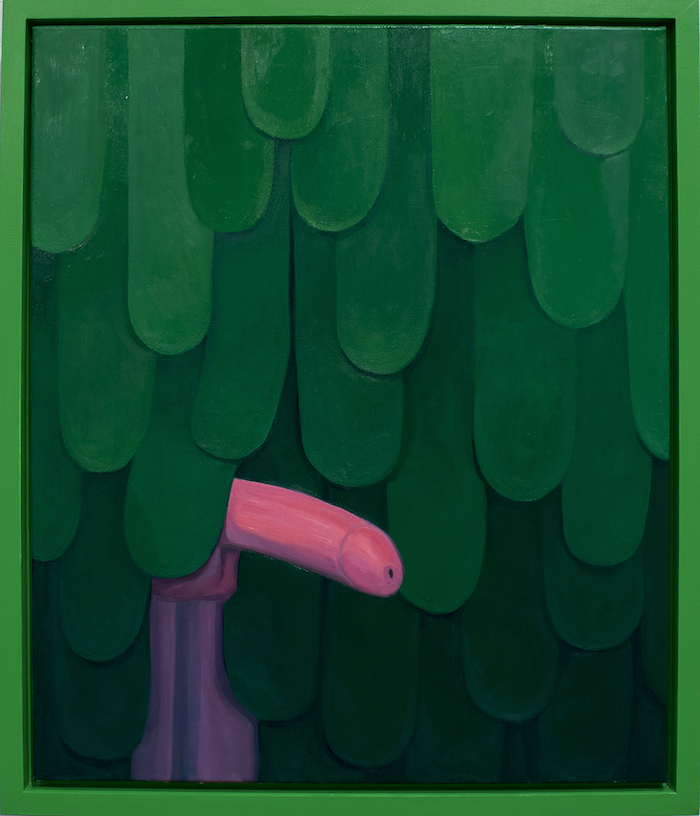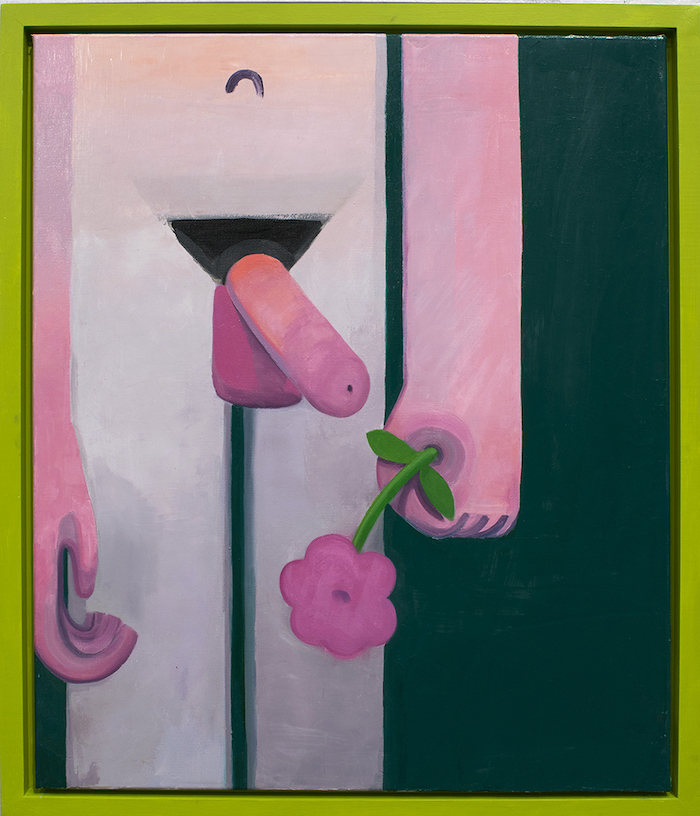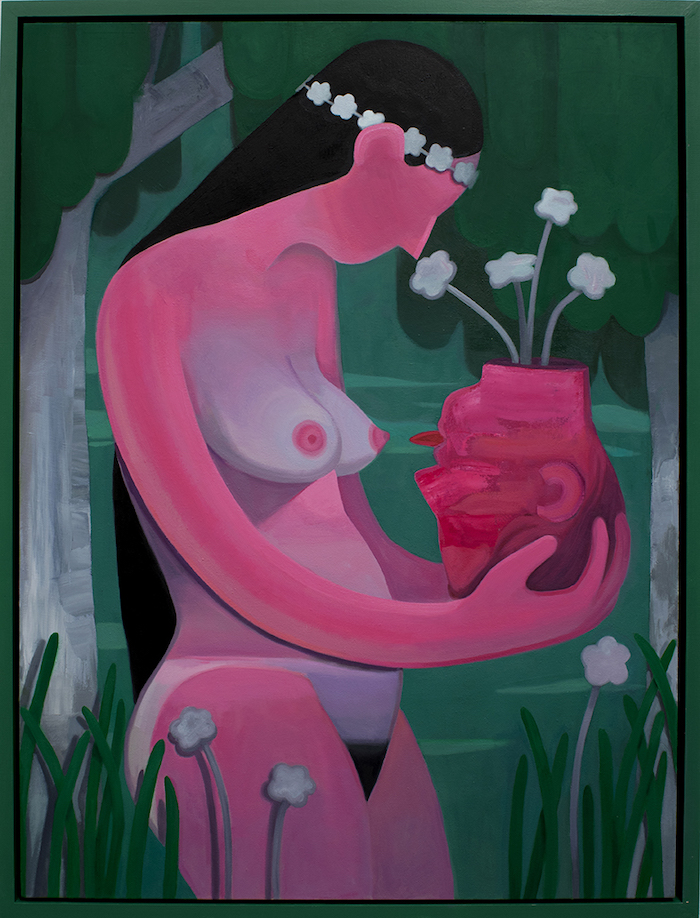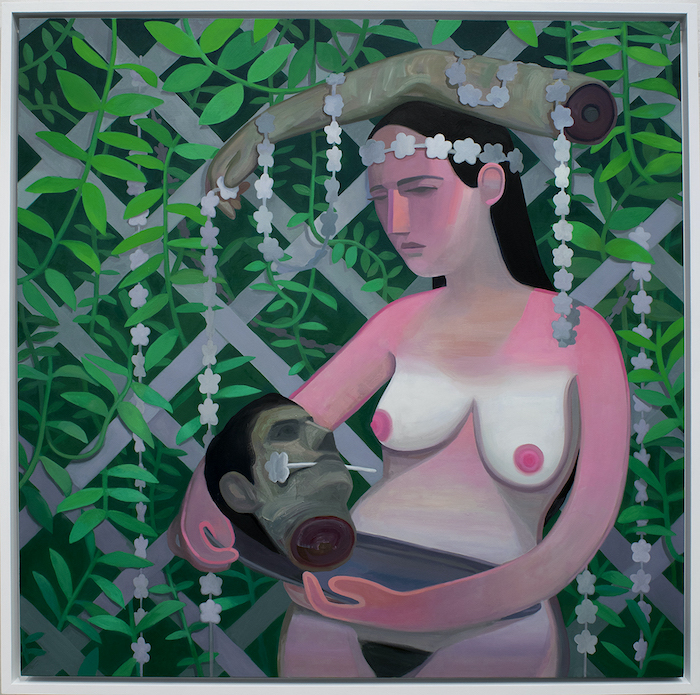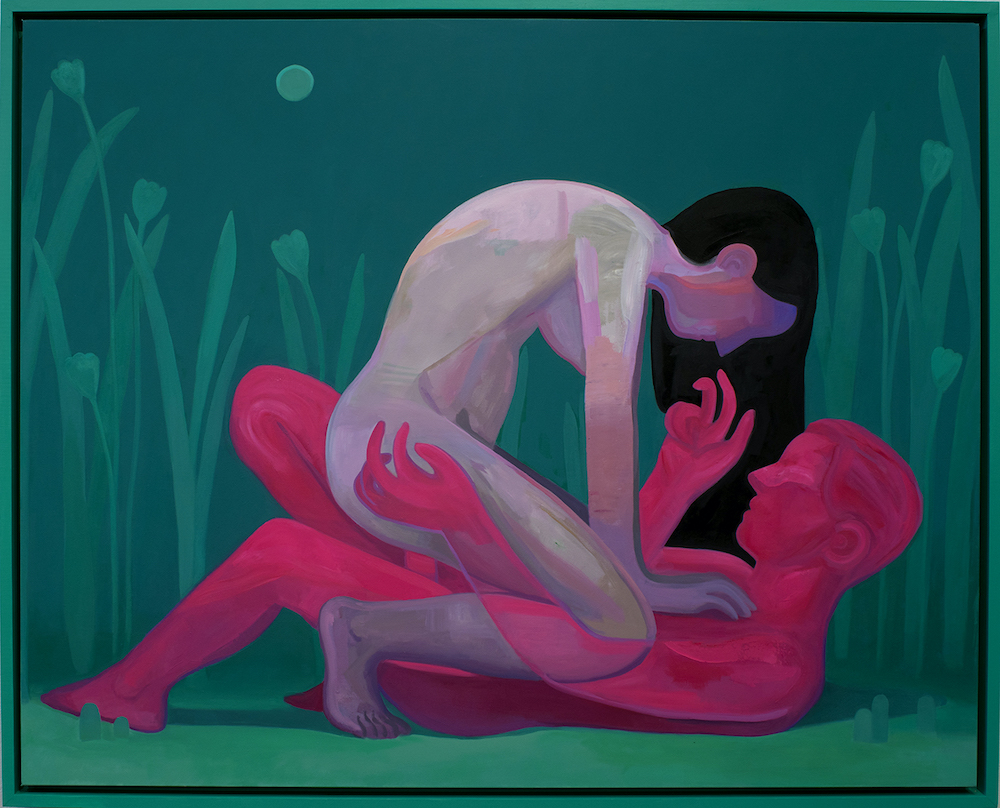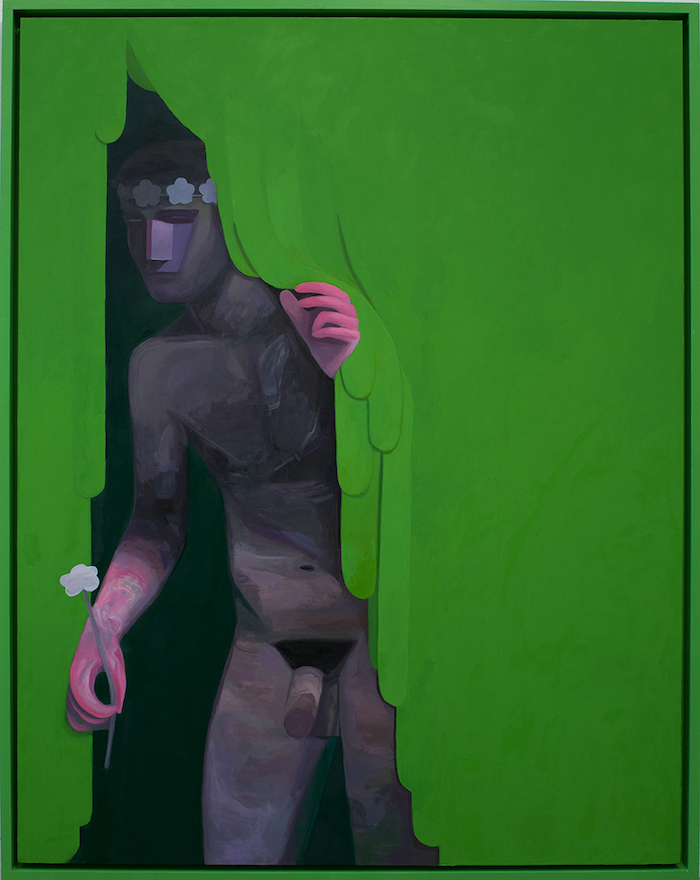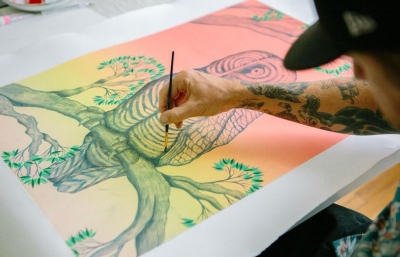We were thinking as to why maybe Florida-based artist Corey Lamb named his show, Verdant. You think of green and growth, and there is plenty of greenery in the new works. But then there is an "unripe in experience or judgment" definition, which maybe gets to the core of it. On Saturday, June 20th, Hashimoto Contemporary in San Francisco will host an IG live walk-through of Verdant, and before hand, Hashimoto's Dasha Matsuura interviewed Lamb to discuss a "deep melancholy and absolute bliss permeate throughout the images” as the figures revel in their voyeuristic sin, be it the creation of corpses or life."
I’m incredibly excited to get to show it this quickly, albeit in kind of strange circumstances but that also feels kind of fitting for the work in a way. They’re both unsettling and comical. How has the current atmosphere framed your work and personal life?
Looking back at the work for this show after two months of living in quarantine, I have a new found appreciation for the level of isolation present in the paintings. Of the nine pieces, only two of the works have moments of real contact where both of the figures are alive and present in the same frame. While that is probably just an expression of my own existential dread, our current situation really reflects how lonesome life on this floating rock can be. To have so much of the world collectively stranded in their own homes has been a surreal situation to live through. But, like the paintings, there are moments from this experience, on a personal level, that have been incredibly positive and have been a counter weight to the grief and worry. For the first time in years, my family and I have had the time to just be together. No school or work to run off to each day. Just being in the same space for such an extended period of time seems like a strange once in a lifetime gift. Even now, the world is slowly opening back up and our previous daily routines are seeping back into our lives.
On a professional level, COVID-19 has been a wrecking ball out of the blue. This work was originally planned for an exhibition at a different gallery in May, but, as we locked down in March, plans and ideas were jettisoned into the void. Lacking any ability to actually hold events, galleries were thrust into the unknown. Some pivoted quickly to online exhibitions while others reached out to their current patrons for support, but, either way, the inability to float exorbitant rents and pay staff salaries has proven to be overwhelming. Obviously, artists have been along for the ride. For those that depend solely on sales, the cancellation of a show could mean complete financial insolvency, immediately. I consider myself incredibly fortunate because my position as a professor has shielded my family financially during this time. Had this happened just a few years ago, when I was a graduate student, I'm not sure how I would have made it through. The level of support Hashimoto Contemporary has given me in this situation is hard to describe. To have a gallery pull your work out of the water and give it a second chance isn't something that happens in the 'regular' world. To say something is uplifting seems so cliche and trite, but that's exactly how I feel. Uplifted.
This series started around your vasectomy in 2018 and reevaluating your relationship to sex, reproduction, masculinity and your partner. How has processing those changes manifested in the work?
Softness. Empathy. Humility. Looking back through the catalog of related works in art history, there is this looming male posturing that dominates the visual expression of male sexuality. Rubens' Rape of the Sabines and Picasso's The Minotaur are representative of this kind of hetero-male orthodox display of sexual power, which is full of muscular aggression. I would like to think my figures are on equal footing, both figures are treated as two rational beings experiencing something together, whether it's sex or death.
Reproduction was probably the hardest component to deal with visually. Sex is so wrapped up in the idea of gratification that its utility is often forgotten or a complete afterthought. My own way of dealing with this was through the presentation of the penis and vagina very directly and with a bit of humor. Bushwhacker, Pollen, Inseparable, and Burial Mound are all dancing around this particular theme. Trying to paint a friendly penis or an ominous vagina is ranked pretty high on my difficulty scale. But, I stand by my private parts.
The work for Verdant feels akin to the center, paradise panel of “The Garden of Earthly Delights”—there’s a similar sense of debauchery and freedom with a looming dread, a lushness of flesh and plants. Is there any particular iconography you’re drawn to for these pieces?
Western iconography, specifically from early christian imagery concerning Eden, played a large part in laying out the essential motifs that comprise these paintings. The use of iconography is meant to be more of a gateway for the viewer. It allows them to enter the work on familiar footing. So, call backs to works like "The Garden of Earthly Delights" make a lot of sense. Granted, a lot of the symbols I use are kind of primal, transcending any one text or tradition; the nude male, the nude female, flowers, trees, plant fronds, and the corpse. I tried to cull anything that wasn't specifically oriented towards life, love, and death.
The work feels very allegorical, almost a retelling of contemporary Eden stories. Do you have specific narratives tied to any of the paintings?
Going to art museums, I have always been drawn to narrative works, both historical and allegorical. One of the problems with this kind of work, however, is that if the viewer lacks the information or context behind what is presented, a lot of the meaning is stripped away and the viewer has to kind of fill in the gaps on their own. This can be a lot of fun, but it can also stunt or mute the impact of the piece. Most narrative works are idiosyncratic to the time in which they were created, many of the characters and events would have been self-evident to contemporaries of the artists. But, time has a way of eroding our collective memory. So, in my own way, I try to create narratives that are self-contained within the frame and title. The characters and spaces are indefinite in their specificity. If they are allegorical, the context exists completely within the individual piece itself. So, the specific narratives of each piece are more concerned with broader statements about life as lived by an individual, which the viewer holds within themselves. If there is a morality to it, it's one wrapped in the lived experience and not some codex outside the self.
You’ve mentioned “post Eden nudity” in regards to your figures' tan lines and awareness of their nudity. Can you expand more on that?
When you work with the nude, especially in an iconic format, the tendency is towards idealization and a particular kind of transcendent state of being, greater than the individual human. This particular read is kind of antithetical to my personal interest. I'm mostly concerned with the human experience right here, right now by your average person. In some ways, the debauchery and mischief are call backs to the grounded nature from which these paintings sprang. Tan-lines are a kind of subtle nod to the fact that these figures usually wear clothes and are not in a state of innocence or naivete. They know what they are doing and they have a sort of agency and intelligence that Eden-esque figures generally lack in art history. They are visitors in the "garden", not dwellers.
Your work balances violence and sexuality with humor and a certain darkness without ever being overpoweringly one element. There are severed limbs that still have levity, nude figures that don’t feel lewd or overly sexualized; how do you balance that tension?
Perhaps this is due to how these elements are being employed within the work and what they are in service to as an overall thematic goal. In a lot of instances, I use sex or death as a sleight of hand to talk about other more complex aspects of a relationship. Humor and melancholy are injected into the image via color, abstraction, and gesture to defuse the bluntness of sex and death or to twist the interpretation away from a simple act of gratification or morbidity. By far, using different levels and types of abstraction within the work is incredibly important in making this content more pliable. Without that particular component, I think the work wouldn't be able to use irony in a way that evokes empathy or humor.
Everything for this show feels very distilled to the essentials, from the stylized figures to the limited green and pink palette, you really get to focus on the flesh and flora. What is your studio practice like to get to those elemental components? Are you making sketches, reworking paintings, etc?
Initially, I worked very intuitively. Zero planning, just straight to the canvas and whatever would happen would happen. Motifs and symbols would kind of just carry on from one painting to the next. It was only after a few months, when the imagery seemed to have stabilized, that I finally started to pick apart what was happening and what that would mean moving forward with a more substantial body of work. Since that time, my process has moved towards planning compositions via sketch and using more orchestrated moves on the surface. I try not to work on a painting unless I know exactly where I am taking it by the end of the session. One of the largest obstacles moving from alla prima painting to multi-session works is that the painting can easily become stagnant or overworked. By limiting my forms, palette, and motifs, it kind of frees me up to keep the application as fresh as possible while maintaining a type of clarity of intent through simplification.
I really enjoy the sense of tactility in your painting and your approach to painting as “acknowledging the totality of the medium.” What most excites you about painting?
The cave paintings found in Chauvet Cave in France can be carbon dated to 30,000 BCE, or earlier, while the earliest forms of writing, cuneiform, date to around 3,500 BCE. What excites me about painting is that I belong to a particular narrative that has been going on for nearly the whole of human memory. Painting has seen civilizations and religions rise and decline, and in its own way has outlived the oldest of known languages. It is a language and system that persists and evolves despite our ever changing understanding of our place within the world and universe at large. Despite having schools and movements, painting is relatively resilient to dogma and authority, as any single practitioner is capable of redefining the discourse through their own practice. The canvas is probably the only place I feel connected with humanity as a whole. That's pretty exciting.
You are also a painting professor. How has teaching painting influenced how you think about your own work?
Teaching forces you to interact with younger generations of artists, who continually bring their own influences and ideas concerning the visual world to their work and to the classroom. This is a significant benefit to an artist, as it doesn't allow you to just sit in your studio and ignore what is going on outside of your walls. Students are perpetually trying to both understand the art world they are entering, while trying to stake out and claim a piece of it for themselves. Being around young, highly motivated individuals keeps my own aspirations high and my energy level up. Hard work is infectious.
You mentioned that you’re a bit of a horror buff. Anything you’ve watched recently that really stuck with you or recommendations?
Oh, I don't know about buff anymore, having young children really put the brakes on my consumption of the genre. However, it is a defining influence in my work. One of my first memories of going to the movie theaters was to see Pet Sematary. I think I was five years old. But concerning the past decade, I have a real affinity for Lars von Trier's aesthetics and narrative intensity. Melancholia, while being nine years old and considered mostly a sci-fi drama, still resonates with me in its depiction of existential dread and absurdist horror. The complexity and layering of emotional responses to the situation they are experiencing is something I can only dream about encompassing within the still frame of a painting. If I ever get the time and space to get caught up, I'm really looking forward to binge watching Ari Aster's and Panos Cosmatos' recent work. Looking at what's going on in the genre, I'm really exited to see new aesthetics and narratives that are diverging from the torture porn era that movies like the Hostel series brought us in the 00s.
Any dream projects or upcoming things you’re working on?
The past year has been one centered around refinement and process, which means I've been a bit reserved in scale and scope. But, I feel like that phase of development is finally ending and I am standing on firm ground to move forward with my work. I've got big plans for the future.
Due to the Coronavirus pandemic, there will be no opening reception for the exhibition, and the gallery will be closed to the public. The exhibition will be on view through the gallery website. An Instagram live walk through of the show is scheduled for Saturday, June 20th. The artist will participate in the live stream.

